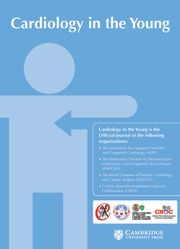No CrossRef data available.
Article contents
Safety and feasibility of transcatheter closure of atrial septal defects in small children weighing less than 10 kg
Published online by Cambridge University Press: 10 October 2024
Abstract
When young patients with an oval fossa defect present early with symptoms of heart failure and pulmonary hypertension, surgical treatment is recommended in small bodyweight rather than transcatheter closure.
Outcomes of device closure in consecutive symptomatic children weighing under 10 kg were compared with young children aged below 4 years but weighing above 10 kg. Transthoracic echocardiography under conscious sedation guided the procedure in all without need for balloon sizing, transesophageal echocardiogram, and intubation anaesthesia. Symptoms, anthropometry, shunt ratio, pulmonary pressures, defect and device size, percentage oversizing, device/body weight ratio, complications, and post-procedural growth spurt were compared.
Ninety-six patients weighing under 10 kg were compared with 160 patients weighing above 10 kg. In total, 83.3% of patients in the study group and 25% of controls were severely malnourished. The median indexed defect size was 35.2 mm/sq.m and 27.4 mm/sq.m, and the device was oversized by 8.7% and 14.2% in the study group and controls, respectively. The device/body weight ratio was 1.93 in study group and 1.4 in controls. Procedure was successful in all except one patient weighing under 10 kg who had a device embolisation. Both groups showed significant growth spurts and proportion, with severe malnutrition reduced to 42% and 11% in the two groups.
Device closure was feasible and safe in patients under 10 kg. Transthoracic echocardiographic imaging on conscious sedation provided adequate guidance. Symptoms and growth significantly improved after intervention. Despite a larger defect size, smaller patients had comparable outcomes. In symptomatic children under 10 kg needing early closure, transcatheter intervention should not be deferred.
Keywords
- Type
- Original Article
- Information
- Copyright
- © The Author(s), 2024. Published by Cambridge University Press



